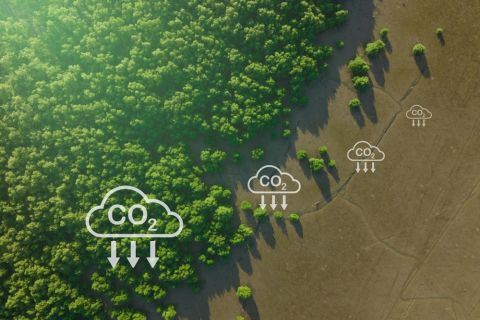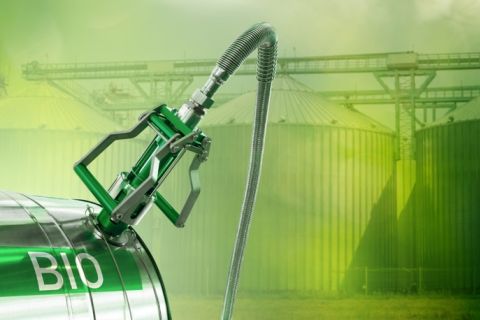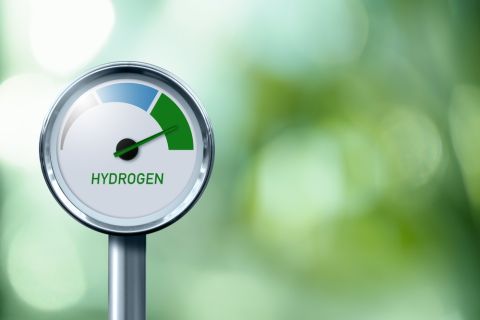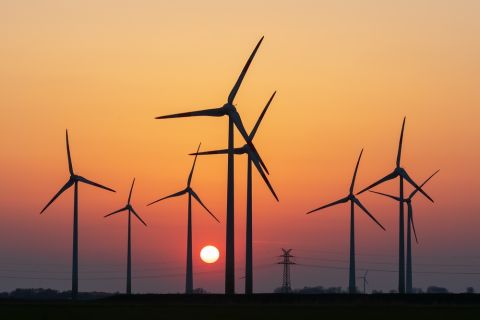Dominion Energy is in the advanced stages of a process to find an equity partner for its $9.8 billion Coastal Virginia Offshore Wind development, aiming to share project costs for the 2.6-gigawatt (GW) project.
Speaking Nov. 3 during the company’s third-quarter 2023 post-earnings call with analysts, Dominion Energy’s CEO Robert Blue said 92% of the project’s costs—excluding current contingency of about $370 million—are fixed. The unfixed costs amount to about $750 million, including onshore electrical work, fuel for transport and installation, plus certain project oversight costs.
“Combined with the prospect of deploying a significant amount of capital into a high-quality long term regulated investment, it’s no surprise to me that the process has generated strong interest,” Blue said.
Drivers generating interest include the project’s “priority position in the offshore wind supply chain, our successful track record of on-time permitting with strong supportive federal agencies, the bipartisan and public support of Virginia political, business and community leadership” as well as the project’s advanced development state and high percentage of fixed costs, he said.
The levelized cost of energy for the project has also dropped to $77/megawatt-hour (MWh), compared to $80 to $90/MWh.
The project, which is the largest being developed in the U.S., continues to move toward its anticipated 2026 completion as the offshore wind industry struggles with high interest rates, supply chain delays and other financial woes. While some have weathered the storm, other developers have been forced to pull out of projects.
RELATED
Ørsted Stock Plummets After Offshore New Jersey Wind Projects Canceled
Dominion’s offshore wind development remains on schedule and on budget, Blue said.
So far, the company has invested $2.3 billion into the project. It expects that number to increase to $3 billion by the end of 2023.
“A properly structured partnership with the optimal counterparty is an attractive option, but only if the terms of a potential transaction make sense for our customers and shareholders,” Blue said. “We expect a decision by year end or in early 2024.”
Here’s a look at other renewable energy project news this week:
Energy Storage
Pilot Plant Arrives for Arizona Lithium’s Saskatchewan Facility
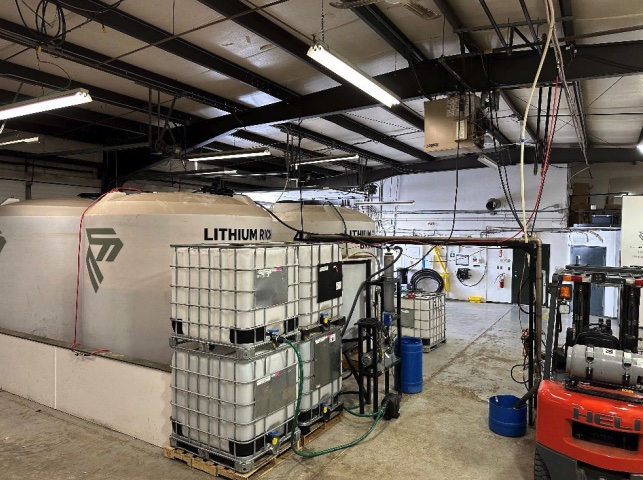
Arizona Lithium Ltd. said Nov. 3 the third-party direct lithium extraction pilot plant arrived at its facility in Saskatchewan, Canada, marking a milestone in its efforts to develop lithium resources in North America.
The equipment will be used to process brine and produce lithium concentrate, which will be sent to Arizona Lithium’s research center in Tempe, Arizona, for analysis. The pilot plant’s arrival comes as the company develops two large projects—Big Sandy in Arizona and Prairie in Canada’s Williston Basin.
“Pilot plant testing of Prairie brine material will complete the third and final phase of the evaluation of a very promising third party supplied DLE technology,” Arizona Lithium said in the release.
E3 Lithium Produces Nearly 100% Pure Lithium Hydroxide Monohydrate
Canada-based E3 Lithium said Oct. 31 it produced 99.78% pure lithium hydroxide monohydrate (LHM), an ingredient for cathode-active material needed for lithium-ion batteries such as those used for electric vehicles.
“Ultimately, E3 Lithium aims to be a supplier directly into the battery industry,” E3 Lithium CEO Chris Doornbos said in a news release. “Demonstrating that we can produce an industry quality specification on conventional and standard industry equipment is an important and exciting step forward. The engineering work continues on this piece of the flow sheet to support the completion of our pre-feasibility study on the Clearwater Project.”
The LHM process included producing lithium concentrate via direct lithium extraction. The lithium concentrate is then converted into LHM, which is crystallized into its final salt form, E3 explained.
The company’s Clearwater project will mine lithium through wells that contain lithium-enriched saline water. The water will be pumped to a central process facility, where the lithium will be extracted and purified.
Standard Lithium Exercises Brine Production Rights Option
Standard Lithium said Oct. 31 it has exercised an option agreement with Tetra Technologies, giving the company brine production rights on about 27,000 net acres of brine leases in Arkansas for a 10-year period.
The agreement, reached with Tetra in 2017, is for leases in Columbia and Lafayette counties where Standard Lithium has since discovered some of the highest reported lithium brine concentrations in North America.
“Our primary goal is to unlock the commercial potential of the Smackover Formation. The TETRA acreage within the SWA project area has delivered outstanding results from our exploration efforts,” Standard Lithium COO Andy Robinson. “Our defined total resource has grown over 100% within the last five years, with an improved average lithium concentration of 437 mg/L. Having secured the exclusive lithium brine rights, we are poised to progress the SWA project to FEED and definitive feasibility study stages.”
The company expects to compete FEED and the feasibility study in 2024, with construction starting in 2025 and commercial production in 2027. A preliminary feasibility study for the project indicated up to 35,000 tonnes per annum (mtpa) of battery-quality lithium hydroxide could be produced over the asset’s 20-year operating life. Production of 30,000 mtpa could yield a pre-tax net present value of $4.5 billion and an IRR of 41%, the company said.
SK Innovation’s Battery Unit Aims to be Profitable in Q4
SK Innovation Co. Ltd., parent of battery maker SK On, said on Nov. 3 its battery business plans to turn a profit in the current quarter after it posted a forecast-beating third quarter operating profit, sending its shares soaring.
SK Innovation, also the owner of South Korea’s biggest oil refiner SK Energy, said it expects fourth-quarter refining margins to remain strong amid low inventory levels, winter stockpiling and recovering China demand.
Operating profit jumped 122% to 1.6 trillion won ($1.20 billion) for the third quarter ended in September, compared with 704 billion won in the same quarter last year and an average analyst forecast of 878 billion won compiled by LSEG SmartEstimate.
SK Innovation’s battery unit SK On, which supplies EV batteries to Ford Motor Co., Volkswagen AG and Hyundai Motor Co., among others, accounted for about 16% of the company’s revenue in the third quarter.
“EV demand growth in North America is expected to outpace EV supplies until 2035, but there has been a slight slowdown in EV growth in North America,” SK On CFO Kim Kyunghoon said in a post-earnings conference call.
Hydrogen
ABB Joins HyPilot PEM Electrolyzer Project
Tech company ABB has joined the HyPilot project, providing its power technology for the in-field demonstration of Hystar’s 1-megawatt (MW) containerized proton exchange membrane (PEM) electrolyzer, according to a news release Oct. 30.
As part of the 10,000-hour project, Norway-based Hystar is testing its technology under realistic field conditions to demonstrate it can be used to cost-effectively and reliably produce green hydrogen at an industrial scale.
Hystar said ABB’s low-harmonic insulated-gate bipolar transistor rectifiers and DC-DC converters will regulate the supply of electricity powering the electrolyzer.
The project at the Kårstø Gas Processing Plant in Rogaland, Norway, is expected to be completed by the end of 2023. Other project partners include Equinor, Yarra and Gassco.
Inpex to Buy into Liquefied Hydrogen Supply Chain Company
Japan’s top oil and gas producer Inpex said on Oct. 31 it would buy a 30% stake in Japan Suiso Energy in a bid to expand its clean energy usage and cut back on fossil fuels.
JSE focuses on large-scale hydrogen liquefaction and transportation technology. Inpex said it agreed to buy the stake for an undisclosed amount from Kawasaki Heavy Industries.
After the deal, Kawasaki will hold a 36.6% stake and Iwatani Corp. will own the remaining 33.4% stake, Inpex added.
Hydrogen and its derivative ammonia are important elements in Japan’s strategy to be carbon-neutral by 2050, and the country wants to boost hydrogen supply to 20 million metric tons annually by then, including via international supply chains.
Solar
Canadian Solar to Invest $800MM to Build 5-GW PV Cell Facility
Canadian Solar Inc. plans to build a 5-GW photovoltaic cell production facility in Indiana, investing more than $800 million, the Ontario-based company said Oct. 30.
Located at the River Ridge Commerce Center in Jeffersonville, Indiana, the facility is expected to start producing about 20,000 high-power modules per day by the end of 2025. Canadian Solar modules produced at the Indiana facility will be used at the 5-GW module assembly plant in Mesquite, Texas.
“Establishing this factory is a key milestone that will enable us to better serve our U.S. customers with the most advanced technology in the industry,” Thomas Koerner, senior vice president of Canadian Solar, said in a news release. “This is the second of the anticipated long-term investments we expect to make in the U.S. as we think strategically about a local, sustainable and clean energy supply chain and to fulfill the long-term requirements of the local-content rules of the recently established IRA [Inflation Reduction Act].”
The IRA, signed into law in 2022, makes available advanced manufacturing production tax credits that can be applied to the domestic production of solar components such as modules, photovoltaic cells and wafers and solar-grade polysilicon, among other items. Facilities that meet domestic content requirements receive a 10% bonus under the production tax credit, according to guidance from the U.S. Treasury Department.
The new facility in Indiana is expected to create about 1,200 jobs, the company said.
First Solar Reports Quarterly Profit on Resilient Demand
U.S. solar panel maker First Solar on Oct. 31 reported a third-quarter profit compared to a year-ago loss on steady demand for renewable energy and raised the lower end of its full-year profit forecast.
It now expects full-year earnings per share of $7.20 to $8 per share, from a previous $7 to $8 per share, essentially raising the mid-point of its outlook to $7.60 per share from $7.50.
The Biden administration’s 2022 Inflation Reduction Act, which allocates about $370 billion toward climate change and clean energy efforts, provides a tax credit for panels made in U.S. benefiting companies such as First Solar.
The U.S. solar industry expects to add a record 32 GW of production capacity this year, up 53% on new capacity in 2022, according to a report by the Solar Energy Industries Association and Wood Mackenzie, despite higher interest rates increasing project costs.
First Solar’s year-to-date bookings have risen to 27.8 GW, the company said.
Solar project developers in the U.S. have flocked to First Solar’s cadmium telluride products, partially because the technology does not rely on polysilicon, a raw material primarily made in China and used in the vast majority of panels.
The company reported a profit of $268.4 million, or $2.50 per share, for the quarter ended Sept. 30, compared to a loss of $49.2 million, or 46 cents per share, in the year-ago period.
First Solar said that construction has been completed at its Indian manufacturing facility and it demonstrated 12,000 modules per day capability.
RELATED
Sunnova Energy Brings in Cash from ITC Sales
Trina Solar to Provide Philippines with 700MW of Solar Modules
Wind
US Greenlights Dominion Energy’s Wind Project Offshore Virginia
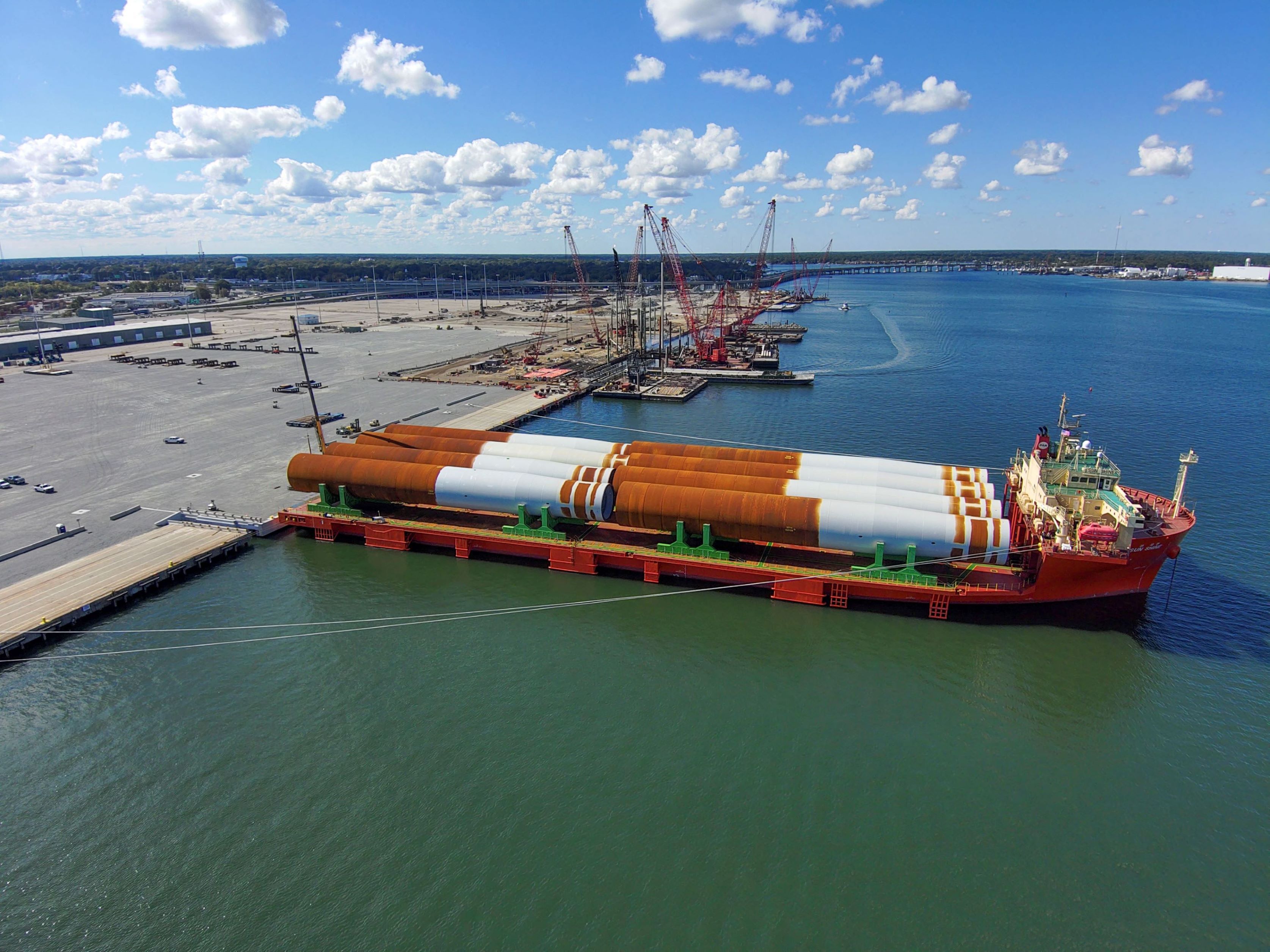
The U.S. Bureau of Ocean Energy Management (BOEM) said Oct. 31 it approved Dominion Energy’s 2.6-GW Coastal Virginia Offshore Wind (CVOW) project, the largest of five commercial offshore wind developments approved by the U.S. to date.
Capable of powering more than 900,000 homes, the project will include 176 wind turbine generators, each with a capacity of 14.7 MW, and three offshore substations. Construction is expected to be complete in 2026, helping move the U.S. closer to its goal of deploying 30 GW of offshore wind capacity by 2030.
“Today’s approval of the largest offshore wind project in U.S. history builds on the undeniable momentum we are seeing,” Secretary of the Interior Deb Haaland said in a statement. “Together with the labor community, industry, Tribes and partners from coast to coast, we are aggressively working toward our clean energy goals.”
Dominion Energy said construction for the project, which is on time and on budget, is scheduled to begin later this year. The first eight monopile foundations were recently offloaded at the Portsmouth Marine Terminal.
“Receiving a favorable Record of Decision from the Bureau of Ocean Energy Management is a monumental achievement for Dominion Energy and the Coastal Virginia Offshore Wind team. More than a decade of work has gone into the development, design and permitting of CVOW,” Dominion Energy CEO Bob Blue said. “Offshore wind is a vital part of our strategy to provide our customers with a diverse fuel mix that delivers reliable, affordable and increasingly clean energy.”
The latest approval follows the approval of Vineyard Wind 1 offshore Massachusetts, South Fork Wind offshore New York, Ocean Wind 1 offshore New Jersey and Revolution Wind offshore Rhode Island. BOEM said the projects will collectively add more than 5 GW of renewable energy to U.S. grids, providing enough to power more than 1.75 million homes.
BOEM said it is on track to complete reviews of at least 16 offshore wind energy project plans by 2025. Together, the projects represent more than 27 GW of clean energy.
Hexicon JV Pursues Wind Offshore Sweden
Floating wind developer Heixcon said Oct. 31 that its Freja Offshore joint venture with Mainstream Renewable Power has applied to develop an offshore wind farm off Sweden.
Called Dyning, the 2.5-GW wind farm will be capable of delivering 10 terawatt hours of energy annually, the company said. The application was submitted to Sweden’s Ministry of Climate and Enterprise.
Hexicon said the wind farm will be located about 45 km offshore Sweden between the mainland and Gotland.
RELATED
BOEM Identifies Four Wind Energy Areas in GoM Amid Concerns
Hart Energy Staff and Reuters contributed to this report.
Recommended Reading
SLB to Acquire Majority Stake in Aker Carbon Capture
2024-03-31 - SLB and Aker Carbon Capture plan to combine their technology portfolios, expertise and operations platforms to bring carbon capture technologies to market faster and more economically, SLB said in a news release.
CIP Acquires Majority Stake in Elgin, Plans $315MM Investment
2024-04-05 - Copenhagen Infrastructure Partners acquired a majority stake in Elgin Energy with plans to invest $316 million in the company.
Bunge, Chevron Announce FID on Oilseed Processing Plant
2024-03-05 - Bunge Chevron Ag Renewables' facility will be used to manufacture low carbon renewable fuels from oilseed.
Shell Taps Bloom Energy’s SOEC Technology for Clean Hydrogen Projects
2024-03-07 - Shell and Bloom Energy’s partnership will investigate decarbonization solutions with the goal of developing large-scale, solid oxide electrolyzer systems for use at Shell’s assets.
Stonepeak Joins Shizen to Form Asian Onshore Wind Platform
2024-03-26 - Stonepeak will have an 80% interest in the onshore wind energy platform, with Japan-based Shizen retaining the remaining 20% interest.


